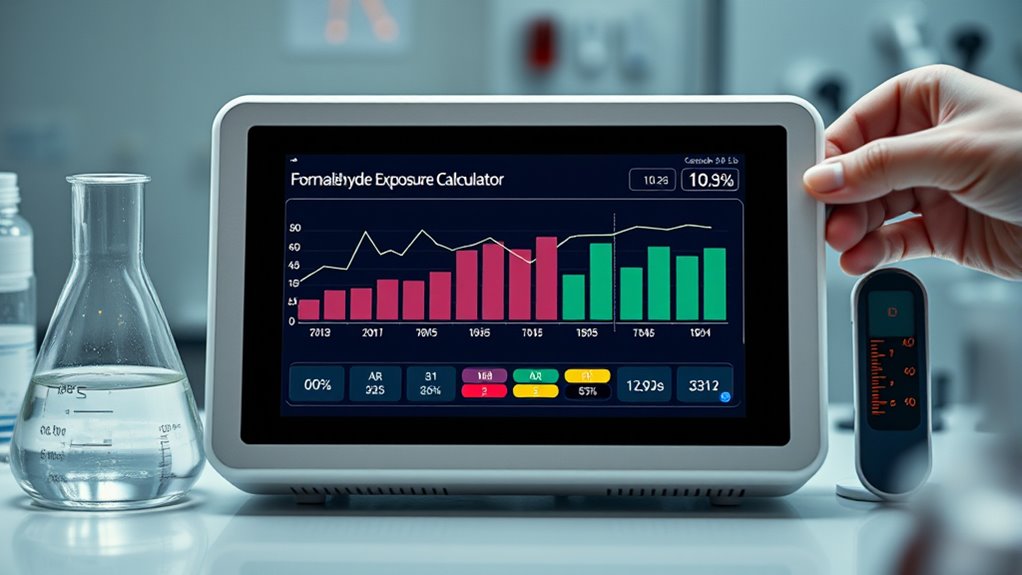A formaldehyde exposure calculator helps you estimate indoor air risks by considering factors like product types, room size, ventilation, and how long you’re exposed. It shows whether formaldehyde levels exceed safety guidelines, allowing you to take targeted steps like increasing airflow or removing high-emitting items. Using this tool empowers you to better understand and manage your indoor environment. Keep exploring to discover how you can effectively reduce your formaldehyde exposure.
Key Takeaways
- A formaldehyde exposure calculator estimates indoor air concentrations based on product types, room size, ventilation, and exposure duration.
- It helps determine if formaldehyde levels exceed safety thresholds set by health agencies.
- The tool enables users to assess potential health risks from off-gassing in homes or workplaces.
- It guides decision-making on ventilation, product removal, or air purification to reduce exposure.
- Regular use supports ongoing monitoring of indoor formaldehyde levels for healthier living environments.

Understanding your exposure to formaldehyde is essential for maintaining a safe indoor environment, especially if you work with or are around products that release this chemical. Formaldehyde is a common indoor air pollutant found in furniture, building materials, textiles, and household products. When these items off-gas, they release formaldehyde molecules into the air, which you then breathe in. Prolonged or high-level exposure to formaldehyde in indoor air can pose significant health risks, including respiratory irritation, allergic reactions, and even increased cancer risk over time. Recognizing these dangers underscores the importance of evaluating and managing your exposure effectively.
A formaldehyde exposure calculator is a practical tool that helps you quantify the potential risks associated with indoor air quality. By inputting specific details about your environment—such as the types of products present, their age, the room size, ventilation rates, and duration of exposure—you can get a clearer picture of how much formaldehyde might be in your indoor air. This information is essential because it enables you to identify whether your current environment exceeds safety thresholds set by health agencies. With this knowledge, you can take targeted actions to reduce your risk, such as increasing ventilation, removing or replacing high-emitting products, or using air purifiers with activated carbon filters.
Using a formaldehyde exposure calculator also helps you understand the relationship between product usage and health risks. For instance, if you’ve recently renovated your home with pressed wood furniture or installed new carpeting, the calculator can estimate how much formaldehyde you’re likely inhaling daily. This can guide you in making informed decisions about whether to continue using those items or wait until the off-gassing diminishes. It also helps you prioritize areas in your home that need improved airflow or additional purification measures.
Ultimately, this tool empowers you to take control of your indoor air quality. It’s not enough to simply be aware that formaldehyde is present; understanding how much you’re exposed to allows you to implement effective mitigation strategies. Regularly evaluating your environment with a formaldehyde exposure calculator keeps you informed about potential health risks and helps you maintain a healthier living and working space. By actively managing formaldehyde levels, you minimize the chance of experiencing adverse health effects, ensuring that your indoor air remains safe for you and your loved ones. Additionally, understanding the sources of formaldehyde off-gassing can help you make better choices about product selection and placement in your home.
Frequently Asked Questions
How Accurate Is the Calculator for Different Indoor Environments?
The calculator is fairly accurate across different indoor environments, but keep in mind manufacturing variability and environmental factors can affect results. Variations in product quality or materials may lead to different off-gassing levels, while factors like temperature, humidity, and ventilation influence formaldehyde concentrations. You should consider these variables when using the calculator, as they can impact the precision of your risk assessment in diverse indoor settings.
Can the Calculator Predict Long-Term Health Effects?
The calculator can give you an estimate of long-term health risks based on cumulative exposure levels, but it can’t definitively predict individual health outcomes. Your risk depends on factors like duration, concentration, and personal health. While it’s useful for understanding potential risks over time, you should consult health professionals for a thorough assessment of long-term health effects, especially if you’re exposed regularly or at high levels.
Does the Calculator Account for All Sources of Formaldehyde?
You might be surprised to learn that the calculator isn’t exhaustive for all formaldehyde sources. While it considers common ones like furniture and building materials, source variability means some hidden or less obvious sources could be overlooked. Around 80% of indoor formaldehyde comes from these main sources, but unaccounted sources can vary greatly, so your exposure assessment might not capture the full picture. Always consider potential additional sources for a more accurate risk evaluation.
How Often Should I Reassess Formaldehyde Levels?
You should reassess formaldehyde levels regularly, ideally every 6 to 12 months, to stay on top of potential health risks. Keep an eye on monitoring frequency and updates in health risk assessments, especially if you make changes to your environment or notice symptoms. Regular checks help guarantee your exposure remains within safe limits, allowing you to take action if levels increase or new risks emerge.
Is There a Mobile App Version of the Calculator Available?
Yes, there’s a mobile app version of the formaldehyde exposure calculator available. It features a user-friendly interface designed for quick assessments on the go. You can easily input your data and get instant risk evaluations right from your smartphone or tablet. This app makes it simple to track and manage formaldehyde off-gassing risks, ensuring you stay informed and safe wherever you are.
Conclusion
Think of this calculator as your trusty lighthouse, guiding you safely through foggy waters of formaldehyde risks. By understanding off-gassing, you’re steering clear of hidden storms that could harm your health. Just like a lighthouse warns sailors of unseen dangers, this tool helps you navigate your home’s air quality with confidence. So, keep the light on, stay informed, and sail smoothly toward a safer, healthier living space. Your peace of mind is worth the journey.









